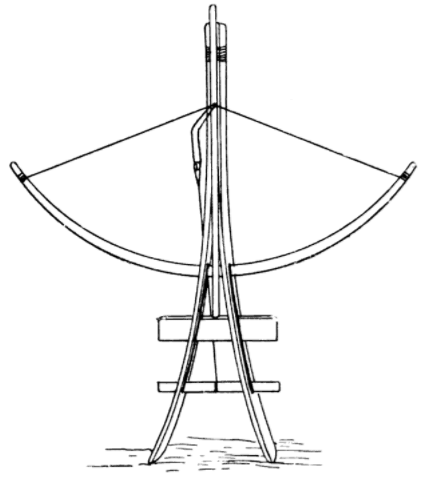Note: This article has been excerpted from a larger work in the public domain and shared here due to its historical value. It may contain outdated ideas and language that do not reflect TOTA’s opinions and beliefs.
Images by John Batchelor, from text.
"Ainu Traps" from The Ainu and Their Folk-lore by John Batchelor, 1901.
The hunters have very few traps, but those which they use are of an old-fashioned but interesting type. The spring-bow used for killing bears and deer stands first.
This instrument consists of three parts: (1) the bow; (2) is a piece of wood which has a slight groove (a) in the end, and which is placed in the centre (b) of the bow; (3) is the trigger, the end of which (c) is placed as to hold the bowstring, whilst (d) which represents the top of the trigger finger is held down by a piece of string (4). From this piece of string (4) another long piece of stout string or rope goes to a tree or pole situated on the opposite side of the trail or run.
As soon as an animal, walking along the trail, touches the string (5) it pulls (4) off the trigger (3) and allows the bowstring to send the arrow into the side of the intruder, be it man or beast.
The next trap to be described is one that is used for catching river otters, foxes, raccoons, hares, and when they are about, wolves. This trap is usually set up in the trails of these animals, so that when they step upon the small piece of string they let the string of the trap loose, and so catch themselves by the leg.
Section (1) is the bow of the trap; (2) is the main frame consisting of a piece of wood split at the end, the two halves being kept apart by the bar at the bottom (3); (4) is a sliding piece of wood having a notch cut into it (a) in which to place and tie the bowstring. The lower end of this piece of wood (b) is placed in a slit, nine inches long, situated above the bar (3), and extending to it; (5) is the cock of the trap. A piece of string runs from the lower bar (3) and passes along under the bow to the trigger, so that when an animal treads upon the string it loosens it from the cock, and causes the bar (4) to come down against (3), where it securely holds the captive by the leg.
These traps are very powerful, and are pretty certain to break the leg of any animal that is so unfortunate as to get caught in one. They are generally secured to a tree near by, to prevent the animals running off with them.
The Ainu have various methods of killing rats. Bows are put up in their runs or trails the same way as they are set for bears and deer, only on a smaller scale. The bears and other large kinds of animals touch the string connected with the trigger with their legs, whilst rats always gnaw it asunder. Another way of rat catching is to suspend a heavy board over some meat which has been connected to some light mechanism for allowing the board to fall when pulled. This is a very sure way of killing a rat
Another rat trap consists merely of an oblong box, with a bow so placed as to close the lid so soon as the animal shall pull the bait which is inside. The trap catches the rat by the middle, the head being inside the trap and the tail out. Fig. 1 shows the top of the trap already set up, and Fig. 2 shows the string inside the trap to which the bait is tied.
John Batchelor, The Ainu and Their Folk-lore (London: The Religious Tract Society, 1901).
About TOTA
TOTA.world provides cultural information and sharing across the world to help you explore your Family’s Cultural History and create deep connections with the lives and cultures of your ancestors.




